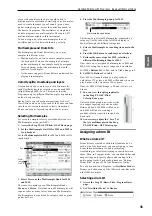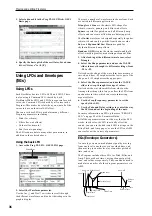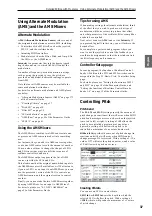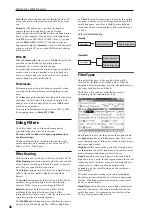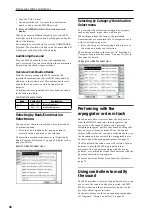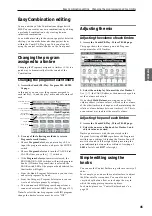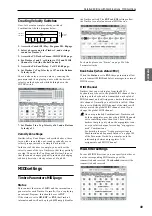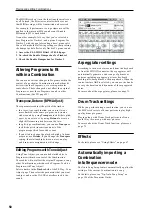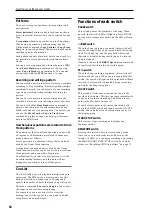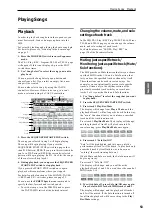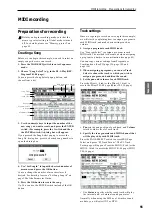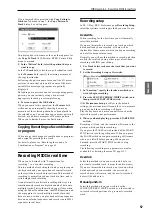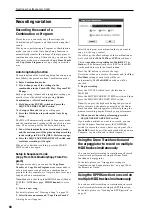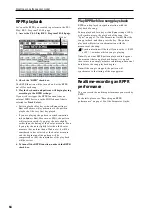
Detailed Editing with Combinations MIDI settings
49
Program
Combination
Sequencer
Effect
Arpeggio
Drum Track
Global
Media
Creating Velocity Switches
Next, let’s create a simple velocity switched
Combination, like the diagram below:
1. Access the Combi P0: Play– Program T01–08 page.
2. Select a brass sound for Timbre 1, and a strings
sound for Timbre 2.
3. Access the P3: Timbre Param– MIDI T01–08 page.
4. For Timbres 1 and 2, set Status to INT and MIDI
Channel to Gch (the Global Channel).
5. Access the P4: Zone/Delay– Vel Z T01–08 page.
6. Set Timbre 1’s Top Velocity to 127, and its Bottom
Velocity to 64.
You can also enter a velocity value by selecting the
parameter and then playing a note with the desired
velocity on the keyboard while holding down the
ENTER switch.
7. Set Timbre 2 to a Top Velocity of 63, and a Bottom
Velocity of 1.
Velocity Zone Slope
Similar to Key Zone Slopes, as described above, these
let you fade in and fade out sounds gradually over a
velocity range, instead of a simple hard switch.
In the case of the above example, you could set the
velocity zones of the two Timbres so that they partially
overlap. Then, set the Top Slope and Bottom Slope so
that the sound changes gradually, instead of changing
suddenly between velocity values of 63 and 64.
MIDI settings
Timbre Parameters MIDI page
Status
This controls the status of MIDI and the internal tone
generator for each Timbre. Normally, if you’re playing
an internal Program, this should be set to INT.
If the status is set to Off, EXT, or EX2, that Timbre’s
internal sounds will not be played. Off simply disables
the Timbre entirely. The EXT and EX2 settings allow
the Timbre to control an external MIDI device.
For details, please see “Status” on page 95 of the
Parameter Guide.
Bank Select (when status=EX2)
When the Status is set to EX2, these parameters allow
you to transmit MIDI Bank Select messages to external
MIDI devices.
MIDI Channel
Timbres that you wish to play from the M50’s
keyboard must be set to the global MIDI channel. Your
playing on the keyboard is transmitted on the global
MIDI channel, and will trigger any timbre that matches
this channel. Normally you will set this to Gch. When
this is set to Gch, the MIDI channel of the timbre will
always match the global MIDI channel, even if you
change the global MIDI channel.
On some preloaded Combinations, Timbres used
by the arpeggiator may have their MIDI Channels
set to something other than Gch. These will be
timbres that play only when the arpeggiator is on–
a very useful technique for creating “arpeggiator-
used” Combinations.
For details, please see “Arpeggiator settings in
Combination and Sequencer modes” on page 109
of the Parameter Guide. In particular, note the
relationships between arpeggiator A/B
assignments and MIDI Channel.
MIDI filter settings
For each MIDI Filter item, you can specify whether or
not the corresponding MIDI message will be
transmitted and received. The checked items will be
transmitted and received.
127
64
63
1
Strings
Velocity
switch
Timbre 1
Timbre 2
Brass
Summary of Contents for EASYSTART M50
Page 1: ...3 E Owner s Manual ...
Page 84: ...Arpeggiator function 78 ...
Page 88: ...Drum Track function 82 ...

